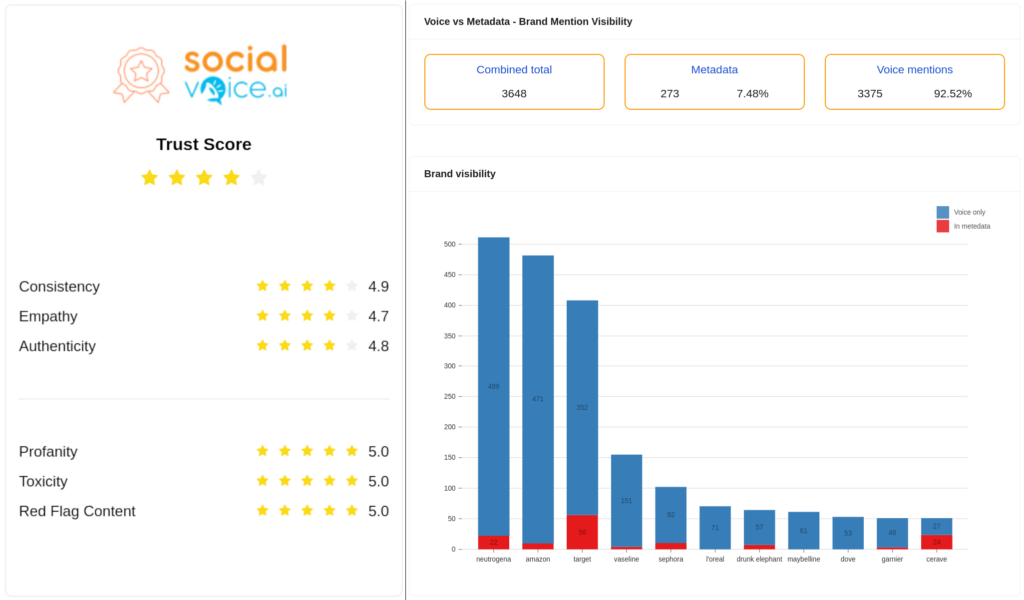
The market opportunity for brands who get influencer marketing right is huge.
According to Goldman Sachs, the creator economy is worth around $250 billion (£205.4bn) today. By 2027, it could hit $480bn (£394.5bn), in line with predicted growth for global digital advertising spend. In line with this trend is an increasing preference for brands to use nano- and micro-influencers in their campaigns. The State of Influencer Marketing 2023 Report puts this at 39% and 30% respectively. With the rise of trends such as FinTok and others front and centre, no longer is there a subject which cannot be touched by an influencer; someone passionate, authentic and knowledgeable enough to earn consumer trust.
Getting the right influencers, in terms of what they say, how they say it and how many people they say it to, is therefore vital. Indeed, an entire martech sector has mushroomed in the form of social listening. Yet Nicholas Greig, chief revenue officer at SocialVoice, has a problem with the term.
“Social listening platforms can’t listen,” explains Greig. “All they can do is scan the metadata.”
While social listening tools can look at hashtags and comments, crunch engagement rates, and look at the sentiment of the written word, SocialVoice believes there is no tool currently on the market which can get ‘inside’ a video and analyse the voice. Until now.
The aim of SocialVoice is to enable analysis of an influencer’s past activity, through every frame of every video on every platform. Tone of voice can be analysed, beyond the written word, to assuage fears around brand safety as well as brand fit. This can go from the usual sentiment analysis to understanding personal versus corporate tone, to extrovert versus introvert, to liberal versus conservative. “Because we’re moving to nano- and micro-influencers, we’re not bringing them in for shoots anymore, so we’re relying on the quality of their recording,” explains Greig.
From a technology standpoint, it will not be a surprise that AI is at the heart of the solution, with three primary facets; deep analysis using machine learning tools, statistical approaches to identify pattern correlation across time-based events, and processing at speed. Almost two thirds of those polled in the State of Influencer Marketing report (63%) plan to use AI in executing their influencer campaigns, with two thirds of those brands using it for influencer identification.
What this looks like in terms of product is the Influencer Integrity Report, the first go-to-market effort from SocialVoice. The analysis of time-based events and processing at speed is combined so brand managers can input the influencer link and then get a report soon afterwards backed up by industry standards – toxic and profane content is based on GARM (Global Alliance for Responsible Media) metrics – and headlined by an overall trust score (left).
In the example MarketingTech saw, regarding a well-known influencer in the skincare industry, a specific brand appeared 273 times based on hashtag and written word analysis. For video scripts, the brand appeared 3648 times (right). Tone of voice noted variance between neutral and joyful.

Greig believes this will solve a fundamental industry problem. “We realised that there were some very big problems in the world of influencer marketing that, despite its growth, were affecting uptake from industry sectors such as banking, or from industry sectors where compliance and conservatism was more prevalent,” says Greig.
“These problems come around the fact that not a single influencer discovery platform in the world can be trusted to do proper vetting, or background checking, of the influencer,” adds Greig. “Checking influencers takes hours, and they can’t go back and check everything that an influencer has ever said – so they cut corners, they look at a random sample of videos, and then they go into a campaign [with a] lack of trust in whether the influencer has any hidden surprises in their background.”
While it remains early days, Greig notes that the trust score is the key element for customers on board thus far. The company has trademarked the term ‘trust my voice’ in anticipation not just of this, but for future cases beyond the brand and agency side. “One of the ways where we see this going forward is that influencers themselves on their profile will have a ‘trust my voice’ link,” offers Greig. “They’ll have that from a software as a service perspective.”
SocialVoice is exhibiting at the upcoming DMWF Europe event, on 21-22 November in Amsterdam, with something a little more enticing than usual. Those who visit the stand will have the ability to have one free check of an influencer of their choice – so the company has a strong bet on their value proposition.
“I think it will shock people as to just how limited the information is they have to make right decisions, and just how open they are to problems,” says Greig.
“We are still very much in a concept [phase],” he adds. “It’s going to be very difficult for anyone to compete against us. It’s not just the AI ability, it’s the scale of what it is that we’re doing; it’s the ability to do it at speed and do thousands of influencers at the same time.”
Insert picture credit: SocialVoice
Interested in hearing leading global brands discuss subjects like this in person? Find out more about Digital Marketing World Forum (#DMWF) Europe, London, North America, and Singapore.





